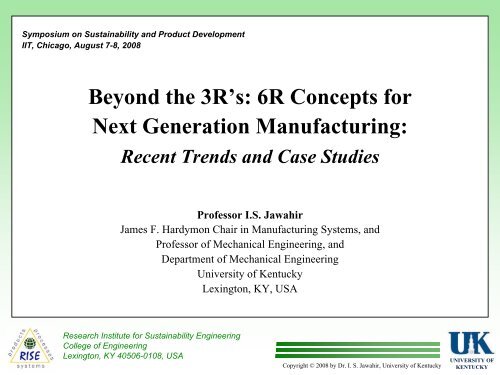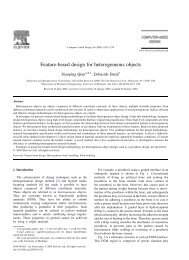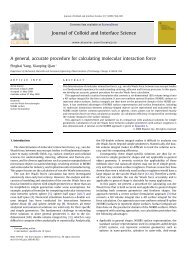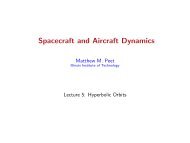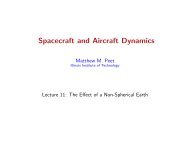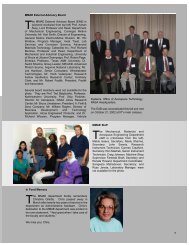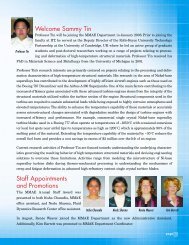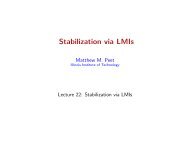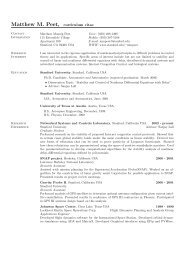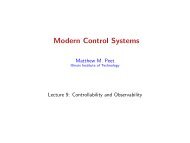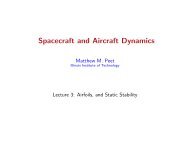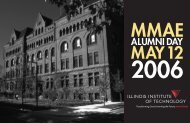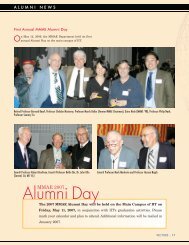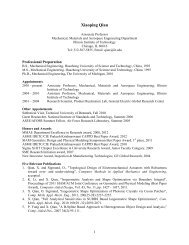Beyond the 3R's: 6R Concepts for Next Generation Manufacturing:
Beyond the 3R's: 6R Concepts for Next Generation Manufacturing:
Beyond the 3R's: 6R Concepts for Next Generation Manufacturing:
- No tags were found...
Create successful ePaper yourself
Turn your PDF publications into a flip-book with our unique Google optimized e-Paper software.
Symposium on Sustainability and Product DevelopmentIIT, Chicago, August 7-8, 2008<strong>Beyond</strong> <strong>the</strong> 3R’s: <strong>6R</strong> <strong>Concepts</strong> <strong>for</strong><strong>Next</strong> <strong>Generation</strong> <strong>Manufacturing</strong>:Recent Trends and Case StudiesProfessor I.S. JawahirJames F. Hardymon Chair in <strong>Manufacturing</strong> Systems, andProfessor of Mechanical Engineering, andDepartment of Mechanical EngineeringUniversity of KentuckyLexington, KY, USAResearch Institute <strong>for</strong> Sustainability EngineeringCollege of EngineeringLexington, KY 40506-0108, USACopyright © 2008 by Dr. I. S. Jawahir, University of KentuckyUNIVERSITY OFKENTUCKY
Presentation Outline• Sustainability: General Background• Total Product Life-cycle Consideration, including End-of-Life Options• Sustainable <strong>Manufacturing</strong>: Definitions, Basic Elements and MostCommon Terms• Product Sustainability Assessment – A Summary• Case Studies:(a)(b)(c)Machining Processes: Sustainability EvaluationConsumer Electronic Products: Development of a Sustainability Scoring Method<strong>for</strong> Laser PrintersAutobody Design and Manufacture: Total Life-cycle Analysis and Applications• National and International Trends• Scientific and Technological ChallengesResearch Institute <strong>for</strong> Sustainability EngineeringCollege of EngineeringLexington, KY 40506-0108, USACopyright © 2008 by Dr. I. S. Jawahir, University of KentuckyUNIVERSITY OFKENTUCKY
Sustainability:General BackgroundResearch Institute <strong>for</strong> Sustainability EngineeringCollege of EngineeringLexington, KY 40506-0108, USACopyright © 2008 by Dr. I. S. Jawahir, University of KentuckyUNIVERSITY OFKENTUCKY
Sustainability: Definitions• “Sustainability” means different things to different people• There is no universally acceptable definition <strong>for</strong> <strong>the</strong> term“sustainability”, but <strong>the</strong> most commonly known definitioncomes from <strong>the</strong> 1987 U.N. Brundtland Commission headedby Dr. Gro Harlem Bruntland:Dr. Gro Harlem Brundtland“ Meeting <strong>the</strong> needs of present without compromising<strong>the</strong> ability of future generations to meet <strong>the</strong>ir ownneeds”• Some of <strong>the</strong> most commonly known sustainability termsare:(a) Environmental Sustainability(b) Economic Sustainability(c) Societal SustainabilityResearch Institute <strong>for</strong> Sustainability EngineeringCollege of EngineeringLexington, KY 40506-0108, USACopyright © 2008 by Dr. I. S. Jawahir, University of KentuckyUNIVERSITY OFKENTUCKY
Similar ThoughtsResearch Institute <strong>for</strong> Sustainability EngineeringCollege of EngineeringLexington, KY 40506-0108, USACopyright © 2008 by Dr. I. S. Jawahir, University of KentuckyUNIVERSITY OFKENTUCKY
SocietyPeopleSUSTAINEnvironmentPlanetEconomyProsperityOBJECTIVESSociety• Improved Health• Safety• Enhanced Qualityof life• EthicsEnvironment• Cleaner Air, Water and Soil(Lower Toxicity & Pollution)• Eco-balance & Efficiency• Greater Implementationof Regulations, Codes, etc.(Improved Logistics)Economy• New Employment• Product and ProcessInnovation (TechnologicalAdvancement)• Large-Scale new businessopportunities(3 new “R”s)Research Institute <strong>for</strong> Sustainability EngineeringCollege of EngineeringLexington, KY 40506-0108, USACopyright © 2008 by Dr. I. S. Jawahir, University of KentuckyUNIVERSITY OFKENTUCKY
Sustainability DriversResearch Institute <strong>for</strong> Sustainability EngineeringCollege of EngineeringLexington, KY 40506-0108, USACopyright © 2008 by Dr. I. S. Jawahir, University of KentuckyUNIVERSITY OFKENTUCKY
Significance of SustainabilitySource: http://www.beechenhill.co.uk/sustainability.htmResearch Institute <strong>for</strong> Sustainability EngineeringCollege of EngineeringLexington, KY 40506-0108, USACopyright © 2008 by Dr. I. S. Jawahir, University of KentuckyUNIVERSITY OFKENTUCKY
How many Earths have we got ??Can a single earth support <strong>the</strong> ever-increasing demands <strong>for</strong> resources ?Research Institute <strong>for</strong> Sustainability EngineeringCollege of EngineeringLexington, KY 40506-0108, USACopyright © 2008 by Dr. I. S. Jawahir, University of KentuckyUNIVERSITY OFKENTUCKY
We will need six Earths <strong>for</strong> all countries to reach <strong>the</strong>U.S. level of consumptionResearch Institute <strong>for</strong> Sustainability EngineeringCollege of EngineeringLexington, KY 40506-0108, USACopyright © 2008 by Dr. I. S. Jawahir, University of KentuckyUNIVERSITY OFKENTUCKY
Sustainable GrowthBalances economic, environmental and societal needsSource: che.chonbuk.ac.kr/data/ BASF%20-%20SH%20Lee%20lecture.pptResearch Institute <strong>for</strong> Sustainability EngineeringCollege of EngineeringLexington, KY 40506-0108, USACopyright © 2008 by Dr. I. S. Jawahir, University of KentuckyUNIVERSITY OFKENTUCKY
SustainableAgricultureSustainableEnergyEconomySustainableTransportationInnovationCreativitySustainableConstruction &BuildingTechnologySustainableHousingEnvironmentSocietySustainableArchitecture &DesignSustainableAssets &ManagementEducation & TrainingSustainable<strong>Manufacturing</strong>SustainableCompanies &Business
SystemsSustainable<strong>Manufacturing</strong>ProductsProcesses
Ever-increasing Traffic Flow and PollutionA traffic jam idles motorists in Bangkok; carbon emissions from gasolineburningcars are one of <strong>the</strong> causes of global worming(Source: TIME Global Warming, 2007)Research Institute <strong>for</strong> Sustainability EngineeringCollege of EngineeringLexington, KY 40506-0108, USACopyright © 2008 by Dr. I. S. Jawahir, University of KentuckyUNIVERSITY OFKENTUCKY
Global WarmingSource: US News & World Report, July 2004Research Institute <strong>for</strong> Sustainability EngineeringCollege of EngineeringLexington, KY 40506-0108, USACopyright © 2008 by Dr. I. S. Jawahir, University of KentuckyUNIVERSITY OFKENTUCKY
US Waste <strong>Generation</strong> Rates and LandfillHow Long Does It Take <strong>for</strong> Some CommonlyUsed Products to Biodegrade ?Source: http://www.zerowasteamerica.org/images/6-1.gifResearch Institute <strong>for</strong> Sustainability EngineeringCollege of EngineeringLexington, KY 40506-0108, USACopyright © 2008 by Dr. I. S. Jawahir, University of KentuckyUNIVERSITY OFKENTUCKY
Automotive and Consumer ProductsResearch Institute <strong>for</strong> Sustainability EngineeringCollege of EngineeringLexington, KY 40506-0108, USASource: http://www.inmagine.com/pdv031/pdv031027-photoCopyright © 2008 by Dr. I. S. Jawahir, University of KentuckyUNIVERSITY OFKENTUCKY
World’s Annual Material WasteResearch Institute <strong>for</strong> Sustainability EngineeringCollege of EngineeringLexington, KY 40506-0108, USACopyright © 2008 by Dr. I. S. Jawahir, University of KentuckyUNIVERSITY OFKENTUCKY
Projected World Population by 2050Research Institute <strong>for</strong> Sustainability EngineeringCollege of EngineeringLexington, KY 40506-0108, USACopyright © 2008 by Dr. I. S. Jawahir, University of KentuckyUNIVERSITY OFKENTUCKY
GDP Growth Rate6Percent/YearGDP Capita Growth Rate543210AsiaDevelopingWorldLatinAmericaAfrica World DevelopedWorldResearch Institute <strong>for</strong> Sustainability EngineeringCollege of EngineeringLexington, KY 40506-0108, USACopyright © 2008 by Dr. I. S. Jawahir, University of KentuckyUNIVERSITY OFKENTUCKY
Most Common E-waste Components• Printed circuit boards• Cathode ray tubes• Wires and cables• Mercury switches• Batteries• Light generators (e.g., lamps)• Capacitors and resistors• Sensors and connectorsResearch Institute <strong>for</strong> Sustainability EngineeringCollege of EngineeringLexington, KY 40506-0108, USACopyright © 2008 by Dr. I. S. Jawahir, University of KentuckyUNIVERSITY OFKENTUCKY
Electronic Waste• Computer equipment is a complicated assembly of more than 1,000components, many of which are hazardous and toxic.• A major culprit in <strong>the</strong> hazardous waste areas is <strong>the</strong> computer monitorand television cathode ray tube (CRT), which contains five to eightpounds of lead.• The non-biodegradable refuse from e-waste and o<strong>the</strong>r sources oftenends up in land-fills or incinerators where toxic substances such asresidues of lead, cadmium, lethal mercury, carcinogenic asbestos, tinplates, arsenic, PVC and plastic waste, lead and cadmium batteriesetc. contaminate <strong>the</strong> land, water and air, posing serious health hazardsand affecting <strong>the</strong> environment.Research Institute <strong>for</strong> Sustainability EngineeringCollege of EngineeringLexington, KY 40506-0108, USASource:http://www.tribuneindia.com/2004/20040322/login/main1.htmCopyright © 2008 by Dr. I. S. Jawahir, University of KentuckyUNIVERSITY OFKENTUCKY
Legislative Drivers• Waste Electrical & Electronic Equipment (WEEE)Directive• Restriction of Hazard Substances (RoHS) Directive• End of Life Vehicles (EoL)• Eco-design of End Use Equipment (EuP) DirectiveResearch Institute <strong>for</strong> Sustainability EngineeringCollege of EngineeringLexington, KY 40506-0108, USACopyright © 2008 by Dr. I. S. Jawahir, University of KentuckyUNIVERSITY OFKENTUCKY
Electronic Waste Covered by <strong>the</strong> WEEE LegislationResearch Institute <strong>for</strong> Sustainability EngineeringCollege of EngineeringLexington, KY 40506-0108, USACopyright © 2008 by Dr. I. S. Jawahir, University of KentuckyUNIVERSITY OFKENTUCKY
Ten Categories of Electronic WastesCovered by <strong>the</strong> WEEE Legislation1. Large Household Appliances - washing machines, fridge/freezers, microwaves, fans,radiators, large appliances <strong>for</strong> heating rooms/beds/seating furniture2. Small Household Appliances - vacuum cleaners, irons, electric knives, clocks, scales3. IT and Telecom.- computers, calculators, phones4. Consumer Equipment - radios, TVs, VCRs5. Lighting Equipment - luminaires (excluding household), straight/compact fluorescentlamps, o<strong>the</strong>rlighting of equipment <strong>for</strong> spreading or controlling light (excluding filamentbulbs)6. Electrical/Electronic Tools (excluding large scale stationary industrial tools) - drills, sewingmachines, sprayer/spreaders, lawn mowers7. Toys & Leisure/Sports Equipment - train sets, video games, cycle computers8. Medical Devices (excluding implanted and infected devices) (Excluded from RoHS) -dialysis, nuclear medicine, freezers9. Monitoring & Control Instruments (Excluded from RoHS) - smoke detectors, <strong>the</strong>rmostats,measuring/weighing appliances10. Automatic Dispensers – coffee/drinks machines, ATMs.Research Institute <strong>for</strong> Sustainability EngineeringCollege of EngineeringLexington, KY 40506-0108, USACopyright © 2008 by Dr. I. S. Jawahir, University of KentuckyUNIVERSITY OFKENTUCKY
Total Life-cycle ConsiderationsandEnd-of-life OptionsResearch Institute <strong>for</strong> Sustainability EngineeringCollege of EngineeringLexington, KY 40506-0108, USACopyright © 2008 by Dr. I. S. Jawahir, University of KentuckyUNIVERSITY OFKENTUCKY
Changing Faces of Life-cycle ProgressionRef: http://www.sciencein<strong>the</strong>box.com/en_UK/sustainability/lifecycleassessment_en.htmlResearch Institute <strong>for</strong> Sustainability EngineeringCollege of EngineeringLexington, KY 40506-0108, USACopyright © 2008 by Dr. I. S. Jawahir, University of KentuckyUNIVERSITY OFKENTUCKY
Cradle to Cradle Approach(Life-cycle Thinking – http://www.ami.ac.uk/courses/topics/0109_lct/)Research Institute <strong>for</strong> Sustainability EngineeringCollege of EngineeringLexington, KY 40506-0108, USACopyright © 2008 by Dr. I. S. Jawahir, University of KentuckyUNIVERSITY OFKENTUCKY
Life-Cycle Stages of a Manufactured ProductSTAGE IV:POST-USESTAGE III:USESTAGE I:PRE-MANUFACTURINGSTAGE II:MANUFACTURINGSource: ALCAN: Life Cycle Management in <strong>the</strong> aluminum industryResearch Institute <strong>for</strong> Sustainability EngineeringCollege of EngineeringLexington, KY 40506-0108, USACopyright © 2008 by Dr. I. S. Jawahir, University of KentuckyUNIVERSITY OFKENTUCKY
Take It Back!Extended Producer Responsibility (EPR) Laws- Require companies to take back products after <strong>the</strong>ir useful life- The goal is to induce manufacturers to# eliminate unnecessary parts# <strong>for</strong>go unneeded packaging# design products that can easily be disassembled, recycled,remanufactured, or reusedSource: http://www.globalchange.umich.edu/gctext/Leo%20Wiegman/Moving%20Toward%20aonomy%20Jan05.pptResearch Institute <strong>for</strong> Sustainability EngineeringCollege of EngineeringLexington, KY 40506-0108, USACopyright © 2008 by Dr. I. S. Jawahir, University of KentuckyUNIVERSITY OFKENTUCKY
Take It Back! (Contd.)• Several countries in Europe, Asia, and Latin America have implemented EPRlegislation <strong>for</strong> a wide range of products, including:- packaging- electric and electronic equipment-vehicles- tires- batteries- office machineryResearch Institute <strong>for</strong> Sustainability EngineeringCollege of EngineeringLexington, KY 40506-0108, USASource: http://www.globalchange.umich.edu/gctext/Leo%20Wiegman/Moving%20Toward%20aonomy%20Jan05.pptCopyright © 2008 by Dr. I. S. Jawahir, University of KentuckyUNIVERSITY OFKENTUCKY
Sustainable <strong>Manufacturing</strong>:Definitions, Basic Elements andMost Common TermsResearch Institute <strong>for</strong> Sustainability EngineeringCollege of EngineeringLexington, KY 40506-0108, USACopyright © 2008 by Dr. I. S. Jawahir, University of KentuckyUNIVERSITY OFKENTUCKY
Sustainable <strong>Manufacturing</strong>: Terms and Definitions• Environmentally-responsible manufacturing• Environmentally benign manufacturing• Cleaner processes (Green manufacturing)• Economically advantageous manufacturing (Leanmanufacturing)• Energy-efficient manufacturing• <strong>Manufacturing</strong> using renewable source of energyResearch Institute <strong>for</strong> Sustainability EngineeringCollege of EngineeringLexington, KY 40506-0108, USACopyright © 2008 by Dr. I. S. Jawahir, University of KentuckyUNIVERSITY OFKENTUCKY
Sustainable <strong>Manufacturing</strong>: Basic ElementsExpectations:• Reducing energy consumption• Reducing waste• Reducing material utilization• Enhancing product durability• Increasing operational safety• Reducing toxic dispersion• Reducing health hazards/Improving health conditions• Consistently improving manufacturing quality• Improving recycling, reuse and remanufacturing• Maximizing sustainable sources of renewable energyResearch Institute <strong>for</strong> Sustainability EngineeringCollege of EngineeringLexington, KY 40506-0108, USACopyright © 2008 by Dr. I. S. Jawahir, University of KentuckyUNIVERSITY OFKENTUCKY
Sustainable <strong>Manufacturing</strong>: Design Objectives• Designing <strong>for</strong> Repair, Reuse and Recycling• Designing <strong>for</strong> Waste Minimization• Designing <strong>for</strong> Product Disassembly• Designing <strong>for</strong> Energy Efficiency• Designing <strong>for</strong> Product Demanufacturing• Designing <strong>for</strong> Remanufacturing• Designing <strong>for</strong> Serviceability• Designing <strong>for</strong> Reduced Materials Use• Design and Manufacture <strong>for</strong> Reduced Costs• Sustainable Design and Manufacture (Designing <strong>for</strong>Sustainability)Research Institute <strong>for</strong> Sustainability EngineeringCollege of EngineeringLexington, KY 40506-0108, USACopyright © 2008 by Dr. I. S. Jawahir, University of KentuckyUNIVERSITY OFKENTUCKY
Sustainable <strong>Manufacturing</strong>: The Paradigm “E”• Ecology• Environment• Energy• Economy• Employment• Empowerment• Education• ExcellenceResearch Institute <strong>for</strong> Sustainability EngineeringCollege of EngineeringLexington, KY 40506-0108, USACopyright © 2008 by Dr. I. S. Jawahir, University of KentuckyUNIVERSITY OFKENTUCKY
Sustainable <strong>Manufacturing</strong>: DefinitionDesign and manufacture of high quality/per<strong>for</strong>mance productswith improved/enhanced functionality using energy-efficient,toxic-free, hazardless, safe and secure technologies andmanufacturing methods utilizing optimal resources andenergy by producing minimum wastes and emissions, andproviding maximum recovery, recyclability, reusability,remanufacturability, with redesign features, and all aimed atenhanced societal benefits and economic impact.Research Institute <strong>for</strong> Sustainability EngineeringCollege of EngineeringLexington, KY 40506-0108, USACopyright © 2008 by Dr. I. S. Jawahir, University of KentuckyUNIVERSITY OFKENTUCKY
Evolution of Sustainable <strong>Manufacturing</strong>Stakeholder ValueInnovation ElementsRemanufactureRedesignRecoverRecycleReuseReduceSustainable <strong>Manufacturing</strong>(Innovative, <strong>6R</strong>-based)Green <strong>Manufacturing</strong>(Environmentally-benign, 3R-based)Lean <strong>Manufacturing</strong>(Waste Reduction-based)Traditional <strong>Manufacturing</strong>(Substitution-based)1980 1990 2000 2010 2020 2030 2040 2050TimeResearch Institute <strong>for</strong> Sustainability EngineeringCollege of EngineeringLexington, KY 40506-0108, USACopyright © 2008 by Dr. I. S. Jawahir, University of KentuckyUNIVERSITY OFKENTUCKY
3RCONCEPT<strong>6R</strong>CONCEPTRAWMATERIALSENERGYWASTESEMISSIONSResearch Institute <strong>for</strong> Sustainability EngineeringCollege of EngineeringLexington, KY 40506-0108, USACopyright © 2008 by Dr. I. S. Jawahir, University of KentuckyUNIVERSITY OFKENTUCKY
Material flow and its Interaction with <strong>6R</strong>sApplication ofLean<strong>Manufacturing</strong><strong>Concepts</strong>REDUCETotal Life-cycle StagesPRE MANUFACTURINGMANUFACTURINGSubsequent(2 nd and beyond)Life-cycle StagesUSEREUSEApplication ofTotalSustainability<strong>Concepts</strong>RECYCLE3R Concept<strong>6R</strong> ConceptPOST USERECOVERREDESIGNREMANUFACTUREAcceptableRecovered MaterialQuality ?YResearch Institute <strong>for</strong> Sustainability EngineeringCollege of EngineeringLexington, KY 40506-0108, USANLandfillCopyright © 2008 by Dr. I. S. Jawahir, University of KentuckyUNIVERSITY OFKENTUCKY
Product Value Gained from <strong>6R</strong>sPost-useSavings ($)gained byconsumerVALUE ($)<strong>Manufacturing</strong>UseReuseRemanufactureRedesignUsePre-manufacturingDisposalDisposalSavings ($)gained bymanufacturerRecycleRecoverLandfillTraditional product life-cycle1 st life-cycle of product (extended life-cycle)2 nd and subsequent life-cycles of productPRODUCT LIFE-CYCLE STAGESResearch Institute <strong>for</strong> Sustainability EngineeringCollege of EngineeringLexington, KY 40506-0108, USACopyright © 2008 by Dr. I. S. Jawahir, University of KentuckyUNIVERSITY OFKENTUCKY
Product Sustainability Assessment:A SummaryResearch Institute <strong>for</strong> Sustainability EngineeringCollege of EngineeringLexington, KY 40506-0108, USACopyright © 2008 by Dr. I. S. Jawahir, University of KentuckyUNIVERSITY OFKENTUCKY
Selected Eco-labels and Products StandardsProduct Specific StandardsForest Stewardship CouncilCertified WoodClean VehiclesCertified Green-e ProgramUS Green Building CouncilLEED Rating SystemCleaner and Greener CertificationResearch Institute <strong>for</strong> Sustainability EngineeringCollege of EngineeringLexington, KY 40506-0108, USAOverall StandardsNatural Step System ConditionsNordic Swan Eco-labelGreen Seal Product StandardsLife Cycle Assessment (LCA)European Union Eco-labelEnergy Star Eco-labelSustainable Textile StandardCopyright © 2008 by Dr. I. S. Jawahir, University of KentuckyUNIVERSITY OFKENTUCKY
Factors Affecting Product SustainabilityResearch Institute <strong>for</strong> Sustainability EngineeringCollege of EngineeringLexington, KY 40506-0108, USACopyright © 2008 by Dr. I. S. Jawahir, University of KentuckyUNIVERSITY OFKENTUCKY
Integral Elements of Design <strong>for</strong> Sustainability (DFS)Research Institute <strong>for</strong> Sustainability EngineeringCollege of EngineeringLexington, KY 40506-0108, USACopyright © 2008 by Dr. I. S. Jawahir, University of KentuckyUNIVERSITY OFKENTUCKY
Product Sustainability AssessmentResearch Institute <strong>for</strong> Sustainability EngineeringCollege of EngineeringLexington, KY 40506-0108, USACopyright © 2008 by Dr. I. S. Jawahir, University of KentuckyUNIVERSITY OFKENTUCKY
Methodology <strong>for</strong> CalculatingProduct Sustainability Index (PSI)A new 3 step methodology is introduced.Step 1:• The product developers need to identify potential influencing factors based onnational/international regulations, federal and state laws, to be important factorsfrom <strong>the</strong>ir own perspective.• Focus on all three components of sustainability.• Focus on all four life-cycle stages.Step 2:• A 3x4 matrix that represents all components of sustainability and all four life-cycle stages.• Allocate a score/rating between 0-10 <strong>for</strong> each influencing factor.• Weighting can be applied to <strong>the</strong> influencing factors based importance.• Non-quantifiable factors can be scored based on designers’ experience and judgment.Research Institute <strong>for</strong> Sustainability EngineeringCollege of EngineeringLexington, KY 40506-0108, USACopyright © 2008 by Dr. I. S. Jawahir, University of KentuckyUNIVERSITY OFKENTUCKY
Analytical Foundation ofProduct Design <strong>for</strong> SustainabilityStep 3:Methodology <strong>for</strong> Calculating PSIPSI( en _ pm)= {[ ∑ IFni=1( en _pm)i]/( n *10)}*100%PSI (en_pm)= Product Sustainability Index <strong>for</strong> Environment componentof Pre-manufacturing stageIF (en_pm)= Influencing Factor rated on a scale of 0-10 <strong>for</strong> <strong>the</strong> Environment componentof Pre-manufacturing stagen = Number of influencing factors consideredResearch Institute <strong>for</strong> Sustainability EngineeringCollege of EngineeringLexington, KY 40506-0108, USACopyright © 2008 by Dr. I. S. Jawahir, University of KentuckyUNIVERSITY OFKENTUCKY
Analytical Foundation ofProduct Design <strong>for</strong> Sustainability (contd.)PSI en= [PSI (en_pm)+ PSI (en_m)+ PSI (en_u)+ PSI (en_pu)]/4where,PSI (en_pm)= Product Sustainability Index <strong>for</strong> Environment component of PremanufacturingstagePSI (en_m)= Product Sustainability Index <strong>for</strong> Environment component of<strong>Manufacturing</strong> stagePSI (en_u)= Product Sustainability Index <strong>for</strong> Environment component of Use stagePSI (en_pu)= Product Sustainability Index <strong>for</strong> Environment component of Post-use stageThe overall product sustainability index (PSI TLC) <strong>for</strong> a product over its total life-cyclePSI TLC= PSI so+ PSI en+ PSI ecPSI so = PSI <strong>for</strong> Society ComponentPSI en = PSI <strong>for</strong> Environment ComponentPSI ec = PSI <strong>for</strong> Economy ComponentResearch Institute <strong>for</strong> Sustainability EngineeringCollege of EngineeringLexington, KY 40506-0108, USACopyright © 2008 by Dr. I. S. Jawahir, University of KentuckyUNIVERSITY OFKENTUCKY
A Framework <strong>for</strong> Comprehensive Total Life-cycleEvaluation Matrix <strong>for</strong> Product SustainabilityPre-manufacturing <strong>Manufacturing</strong> Use Post-useScoreout of 10Influencing Factors in <strong>the</strong> Product Life-cycle StagesScoreout of 10Scoreout of 10Scoreout of 10Material Extraction 7 Production Energy Used 7 Emissions 9 Recyclability 7Design <strong>for</strong> Environment 8 Hazardous Waste Produced 9 Functionality 8 Remanufacturability 8EnvironmentMaterial Processing 6 Renewable Energy Used 8 Hazardous Waste Generated 9 Redesign 7Landfill Contribution 7(%) PSI (en_pm) = 70 (%) PSI (en_m) = 80 (%) PSI (en_u) = 86.67 (%) PSI (en_pu) = 72.5(%) PSI en =77.29Sustainability ComponentsWorker Health 8 Work Ethics 7 Product Pricing 7 Take-back Options 7Work Safety 8 Ergonomics 7 Human Safety 9 Re-use 6Ergonomics 7 Work Safety 8 Upgradeablility 7 Recovery 7SocietyComplaints 8(%) PSI so = 73.54(%) PSI (so_pm) = 76.67 (%) PSI (so_m) = 73.33 (%) PSI (so_u) = 77.5 (%) PSI (so_pu) = 66.67Raw Material Cost 6 Production Cost 6 Maintenance Cost 7 Recycling Cost 7Labor Cost 3 Packaging Cost 7 Repair Cost 6 Disassembly Cost 8Energy Cost 8 Consumer Injury Cost 8 Disposal Cost 4Economy Transportation Cost 5 Consumer Warranty Cost 7 Remanufacturing Cost 7 (%) PSI ec = 61.25(%) PSI (ec_pm) = 45 (%) PSI (ec_m) = 65 (%) PSI (ec_pu) = 70 (%) PSI (ec_pu) = 65(%) PSI pm = 63.89 (%) PSI m = 72.78 (%) PSI u = 78.06 (%) PSI pu = 68.06 (%) PSI TLC = 70.69SymbolScoreExcellent85-90%Good70-84%Average50-69%Poor< 50%Research Institute <strong>for</strong> Sustainability EngineeringCollege of EngineeringLexington, KY 40506-0108, USACopyright © 2008 by Dr. I. S. Jawahir, University of KentuckyUNIVERSITY OFKENTUCKY
Generic Product Sustainability ScoreAir PollutionRecyclability10MaterialConsumption010100Reliability0Price of ProductWorkerSafetyFuel EconomyHazardousSubstanceSociety Environment EconomyA Generic product sustainability score showing <strong>the</strong> influence of variousfactors on society, environment and economy and <strong>the</strong>ir sustainability ratingsResearch Institute <strong>for</strong> Sustainability EngineeringCollege of EngineeringLexington, KY 40506-0108, USACopyright © 2008 by Dr. I. S. Jawahir, University of KentuckyUNIVERSITY OFKENTUCKY
Matrix <strong>for</strong> Assessing <strong>the</strong> <strong>6R</strong>sProduct Life-cycle Stages <strong>for</strong> Multiple Life-cycles1st Life-cycleSubsequent Life-cyclesPre-<strong>Manufacturing</strong> <strong>Manufacturing</strong> Use Post-use Pre-<strong>Manufacturing</strong> Use Post-use<strong>Manufacturing</strong>Sustainability ComponentsEnvironmentSocietyEconomyR1R1R1R1 R1 R1 R2 R3R4 R5 R<strong>6R</strong>1R1R1 R2 R3R4 R5 R<strong>6R</strong>1R1R1 R2 R3R1 R2R5R1 R2R5R1 R2 R3R1 R2 R3R<strong>6R</strong>1 R2 R3R<strong>6R</strong>1 R2 R3R1 R2R1 R2 R3R1 R2R1 R2 R3R4 R5 R<strong>6R</strong>1 R2 R3R4 R5 R<strong>6R</strong>1 R2 R3R4 R5 R<strong>6R</strong>4 R5 R<strong>6R</strong><strong>6R</strong>4 R5 R<strong>6R</strong>1 - Reduce R2 - Reuse R3 - Recycle R4 - Recover R5 - Redesign R6 - RemanufactureMatrix showing a generic scoring methodology <strong>for</strong> assessing <strong>the</strong> <strong>6R</strong>s in terms ofeconomy, environment and society <strong>for</strong> multiple life-cycles.Research Institute <strong>for</strong> Sustainability EngineeringCollege of EngineeringLexington, KY 40506-0108, USACopyright © 2008 by Dr. I. S. Jawahir, University of KentuckyUNIVERSITY OFKENTUCKY
Reduce, Reuse, Recycle:The Key to Sustainable Product <strong>Manufacturing</strong>• Internal program <strong>for</strong> sustainable product design &manufacturing• Reduces energy use• Reduces manufacturing waste• Reduces water use• Reduces emissions• ISO 14001 certification• ISO 14040 compliant product life cycle assessments (LCAs)Research Institute <strong>for</strong> Sustainability EngineeringCollege of EngineeringLexington, KY 40506-0108, USACopyright © 2008 by Dr. I. S. Jawahir, University of KentuckyUNIVERSITY OFKENTUCKY
Recyclable to Certified Sustainable ProductReduceReduceRemanufactureReuseCertifiedSustainableProductRecycleReuseRedesignRecoverRecycleResearch Institute <strong>for</strong> Sustainability EngineeringCollege of EngineeringLexington, KY 40506-0108, USACopyright © 2008 by Dr. I. S. Jawahir, University of KentuckyUNIVERSITY OFKENTUCKY
Case Studies and Present TrendsResearch Institute <strong>for</strong> Sustainability EngineeringCollege of EngineeringLexington, KY 40506-0108, USACopyright © 2008 by Dr. I. S. Jawahir, University of KentuckyUNIVERSITY OFKENTUCKY
Turning Operations2-D Cyclic Chip Formation 3-D Cyclic Chip FormationResearch Institute <strong>for</strong> Sustainability EngineeringCollege of EngineeringLexington, KY 40506-0108, USACopyright © 2008 by Dr. I. S. Jawahir, University of KentuckyUNIVERSITY OFKENTUCKY
Basic Sustainability Elements in MachiningEnvironmentalFriendlinessMachiningCostPersonnelHealthSustainableMachiningProcessesPowerConsumptionOperationalSafetyWasteManagementFuzzy natureAnalyticalResearch Institute <strong>for</strong> Sustainability EngineeringCollege of EngineeringLexington, KY 40506-0108, USACopyright © 2008 by Dr. I. S. Jawahir, University of KentuckyUNIVERSITY OFKENTUCKY
Regulating (En<strong>for</strong>cing) OrganizationsMethodologies to measure sustainability variables as wellas regulations used to set <strong>the</strong> range of <strong>the</strong> variables can beobtained from many sources:• National Institute <strong>for</strong> Occupational Safety and Health (NIOSH)• Occupational Health and Safety Administration (OSHA)• Environmental Protection Agency (EPA)• Safety & Health Assessment & Research <strong>for</strong> Prevention (SHARP), etc.Research Institute <strong>for</strong> Sustainability EngineeringCollege of EngineeringLexington, KY 40506-0108, USACopyright © 2008 by Dr. I. S. Jawahir, University of KentuckyUNIVERSITY OFKENTUCKY
Sustainability Index: First ApproachOperationalsafety+PersonnelhealthMachiningcostPowerconsumptionWastemanagement+Environmentalfriendliness⎛ MC MC ⎞ ⎛ PC PC ⎞ ⎛ CB CB ⎞min−min−−minS = CMC⋅⎜+ 1 CPC+ CCB⋅+ SMC MC⎟ + ⋅⎜+ 1PC PC⎟⎜CB CB⎟⎝ max−min ⎠ ⎝ max−min ⎠ ⎝ max−min ⎠Research Institute <strong>for</strong> Sustainability EngineeringCollege of EngineeringLexington, KY 40506-0108, USASHEf (V, f, d) F (s i )Copyright © 2008 by Dr. I. S. Jawahir, University of KentuckyUNIVERSITY OFKENTUCKY
Methodology <strong>for</strong> SSHES SHEPrimary fuzzy rulesOperationalsafetyPersonnelhealthEnvironmentalfriendlinessSecondary fuzzy rulesOperatorsafetyProcesssafetyWorkplacecontaminationWastesRecyclingTertiary fuzzy rulesMachining sustainability variablesResearch Institute <strong>for</strong> Sustainability EngineeringCollege of EngineeringLexington, KY 40506-0108, USACopyright © 2008 by Dr. I. S. Jawahir, University of KentuckyUNIVERSITY OFKENTUCKY
Proposed Overall Sustainability Index <strong>for</strong> MachiningS=CSHE⋅SSHE+Cop⋅Sopwhere S SHE= sustainability index <strong>for</strong> safety, health and environmentalissues assessed using fuzzy logic,S op represents <strong>the</strong> operational sustainability level of <strong>the</strong> processaccording to <strong>the</strong> cost of machining, power consumption andwaste management, andC SHE and are weighting factors.C opResearch Institute <strong>for</strong> Sustainability EngineeringCollege of EngineeringLexington, KY 40506-0108, USACopyright © 2008 by Dr. I. S. Jawahir, University of KentuckyUNIVERSITY OFKENTUCKY
Optimization <strong>for</strong> Operational Sustainability IndexFor <strong>the</strong> multi-pass turning operation problems,S( V , f , d ,( i 1,2,... N))op i i i==1N ⎡ ⎛ MC= ⎥ ⎤min− MCi⎞ ⎛ PCmin− PCi⎞ ⎛ CBi− CBmin⎞⎢C⋅⎜+⎟ + ⋅⎜+⎟ + ⋅⎜⎟MC1 CPC1 CCB⎣ ⎝ MCmax− MCmin⎠ ⎝ PCmax− PCmin⎠ ⎝ CBmax− CB ⎠⎦∑N i 0 minwhere <strong>the</strong> N parameter is <strong>the</strong> number of passes in a turning operation,V i is <strong>the</strong> cutting speed, f i is <strong>the</strong> feed rate and d i is <strong>the</strong> depth of cut <strong>for</strong> eachpassConstraints are presented as :MCmin≤MCi ≤ MCmax, PCmin≤ PCi≤ PCmax, CBmin≤ CBi≤ CBmax,( i =1,2,... N)Research Institute <strong>for</strong> Sustainability EngineeringCollege of EngineeringLexington, KY 40506-0108, USACopyright © 2008 by Dr. I. S. Jawahir, University of KentuckyUNIVERSITY OFKENTUCKY
The Structure of <strong>the</strong> Optimization ProcessMetalCuttingTheoriesSelectOptimizationObjectivesDatabase ofExperimentalResultsProcessModelOptimizationAlgorithm(SA)Most SustainableCutting ConditionsNumericalMethodsSet Constraintsof MachiningSustainabilityMeasuresResearch Institute <strong>for</strong> Sustainability EngineeringCollege of EngineeringLexington, KY 40506-0108, USACopyright © 2008 by Dr. I. S. Jawahir, University of KentuckyUNIVERSITY OFKENTUCKY
Optimization ConstraintsConstraints <strong>for</strong> two-pass turningM RTwo-pass turningTurning pass Roughing pass Finishing passV (m / min)150-250 250-400f ( mm / rev)0.15-0.254 0.056-0.15d(mm)1.20-1.905 0.254-1.20MC($)1.7-2.6 2.5-4.1PC(KW )2.5-3.4 1.3-2.2CB 0.6 0.7R a( μ m)(N)F c3( mm / min)(min)3.2 0.81200 50030 000 15 000T 6.00 2.00Research Institute <strong>for</strong> Sustainability EngineeringCollege of EngineeringLexington, KY 40506-0108, USACopyright © 2008 by Dr. I. S. Jawahir, University of KentuckyUNIVERSITY OFKENTUCKY
Optimization Results <strong>for</strong> Two-pass TurningTotal depth of cut 2.7 (P) 2.9 (Q)[ C C , C ]MCOptimumcuttingconditions, [0.8,0.15,0.05] [0.6,0.35,0.05] [0.8,0.15,0.05] [0.6,0.35,0.05]PCCBTurning pass Rough Finish Rough Finish Rough Finish Rough FinishV (m / min) 150 250 150 250 150 250 150 257( mm / rev)(mm)f 0.247 0.116 0.235 0.116 0.229 0.112 0.215 0.107d 1.613 1.087 1.613 1.087 1.771 1.129 1.817 1.083Predictedmachiningper<strong>for</strong>manceandsustainabilityR a( μ m) 2.491 0.800 2.227 0.800 2.153 0.775 1.866 0.739F c(N) 1091 361 1037 361 1091 365 1051 3373M R( mm / min) 59782 31440 56798 31432 60936 21756 58635 30002T (min) 6.307 4.260 6.489 4.261 6.129 4.199 6.228 4.166MC ($) 1.734 2.500 1.782 2.500 1.853 2.578 1.935 2.619PC (KW ) 3.207 1.770 3.048 1.769 3.210 1.788 3.089 1.704CB 0.67 0.76 0.68 0.76 0.64 0.75 0.64 0.77S 83.58 92.17 71.80 81.73 73.38 94.12 67.47 92.41opSop87.88 76.77 83.75 79.94Research Institute <strong>for</strong> Sustainability EngineeringCollege of EngineeringLexington, KY 40506-0108, USACopyright © 2008 by Dr. I. S. Jawahir, University of KentuckyUNIVERSITY OFKENTUCKY
Contour Plot (Roughing)Feasible region in rough turning, V = 150 m/min, d t= 2.7 mmC , C , C = 0.8,0.15,0.05MC PC CBResearch Institute <strong>for</strong> Sustainability EngineeringCollege of EngineeringLexington, KY 40506-0108, USA[ ] [ ]Copyright © 2008 by Dr. I. S. Jawahir, University of KentuckyUNIVERSITY OFKENTUCKY
Contour Plot (Finishing)Feasible region in finish turning, V = 150 m/min, d t= 2.7 mmC , C , C = 0.8,0.15,0.05MC PC CBResearch Institute <strong>for</strong> Sustainability EngineeringCollege of EngineeringLexington, KY 40506-0108, USA[ ] [ ]Copyright © 2008 by Dr. I. S. Jawahir, University of KentuckyUNIVERSITY OFKENTUCKY
Proposed Sustainability Rating SystemEnvironmental FriendlinessEnergyConsumption8PersonnelHealth66203 7WasteReductionOperational SafetyMachiningCost0 2 4 6 8 10worstbestResearch Institute <strong>for</strong> Sustainability EngineeringCollege of EngineeringLexington, KY 40506-0108, USACopyright © 2008 by Dr. I. S. Jawahir, University of KentuckyUNIVERSITY OFKENTUCKY
Case Study 2Consumer Electronic Products:Development of a Sustainability ScoringMethod <strong>for</strong> Laser PrintersResearch Institute <strong>for</strong> Sustainability EngineeringCollege of EngineeringLexington, KY 40506-0108, USACopyright © 2008 by Dr. I. S. Jawahir, University of KentuckyUNIVERSITY OFKENTUCKY
Various Types of Laser and Inkjet PrintersLaser PrintersResearch Institute <strong>for</strong> Sustainability EngineeringCollege of EngineeringLexington, KY 40506-0108, USAInkjet PrintersRef: www.lexmark.comCopyright © 2008 by Dr. I. S. Jawahir, University of KentuckyUNIVERSITY OFKENTUCKY
Elements of SustainabilityEnvironmentalImpactSocietalImpactResourceUtilization/EconomyProductSustainabilityScoringModelRecyclability/RemanufacturabilityFunctionalityManufacturabilityResearch Institute <strong>for</strong> Sustainability EngineeringCollege of EngineeringLexington, KY 40506-0108, USACopyright © 2008 by Dr. I. S. Jawahir, University of KentuckyUNIVERSITY OFKENTUCKY
Framework <strong>for</strong> <strong>the</strong> Product Sustainability ModelProductSustainability Index6 SustainabilityElements24 Sub-ElementsThe index is <strong>the</strong>weighted average of<strong>the</strong>se sub elementsThese factors areequally weighted44 InfluencingFactorsResearch Institute <strong>for</strong> Sustainability EngineeringCollege of EngineeringLexington, KY 40506-0108, USACopyright © 2008 by Dr. I. S. Jawahir, University of KentuckyUNIVERSITY OFKENTUCKY
Environmental ImpactSUSTAINABILITYELEMENTSSUB-ELEMENTSINFLUENCING FACTORSEnvironmental Impact Life-cycle factor Recovery rate after first lifeRecovery costPotential <strong>for</strong> next lifeEnvironmental effectsToxic substancesEmissionResearch Institute <strong>for</strong> Sustainability EngineeringCollege of EngineeringLexington, KY 40506-0108, USACopyright © 2008 by Dr. I. S. Jawahir, University of KentuckyUNIVERSITY OFKENTUCKY
Societal ImpactSUSTAINABILITYELEMENTSSUB-ELEMENTSINFLUENCING FACTORSSocietal Impact Ethical responsibility Take back optionsProduct pricingSocietal impactSafetyQuality of lifeResearch Institute <strong>for</strong> Sustainability EngineeringCollege of EngineeringLexington, KY 40506-0108, USACopyright © 2008 by Dr. I. S. Jawahir, University of KentuckyUNIVERSITY OFKENTUCKY
FunctionalitySUSTAINABILITYELEMENTSSUB-ELEMENTSINFLUENCING FACTORSFunctionality Reliability Type of materialMaintenance scheduleService life/DurabilityUpgradeabilityMaintenance scheduleEase of installationOption <strong>for</strong> upgradeModularityErgonomicsMaintainability/ServiceabilityModules availableSafetyMaintenance scheduleResearch Institute <strong>for</strong> Sustainability EngineeringCollege of EngineeringLexington, KY 40506-0108, USACopyright © 2008 by Dr. I. S. Jawahir, University of KentuckyUNIVERSITY OFKENTUCKY
Resource Utilization & EconomySUSTAINABILITYELEMENTSResource Utilization andEconomySUB-ELEMENTSEnergy efficiencyMaterial utilizationUse of renewable source of energyMarket valueOperational costINFLUENCING FACTORSProduction energyEnergy <strong>for</strong> useRecycle energyType of materialQuantity of materialCost of materialOption <strong>for</strong> o<strong>the</strong>r energy sourcesCurrent market valueCost to operateResearch Institute <strong>for</strong> Sustainability EngineeringCollege of EngineeringLexington, KY 40506-0108, USACopyright © 2008 by Dr. I. S. Jawahir, University of KentuckyUNIVERSITY OFKENTUCKY
ManufacturabilitySUSTAINABILITYELEMENTSSUB-ELEMENTSINFLUENCING FACTORSManufacturability Packaging Take back optionsPackaging materialQuantity usedAssemblyTransportationStorageNumber of parts/componentsCost of transportationCost <strong>for</strong> storageDuration of storageResearch Institute <strong>for</strong> Sustainability EngineeringCollege of EngineeringLexington, KY 40506-0108, USACopyright © 2008 by Dr. I. S. Jawahir, University of KentuckyUNIVERSITY OFKENTUCKY
Methodology• Each influencing factor can be quantified differently, and <strong>the</strong>y are all on ascale of 0-1, where 0 is <strong>the</strong> lowest and 1 being <strong>the</strong> highest rating.• Three categories represent <strong>the</strong> relative importance of all sub-elementsagainst each o<strong>the</strong>r: high, medium and low.• This grouping technique creates a weighting factor as well as <strong>the</strong>simplification <strong>for</strong> any customization or changes <strong>for</strong> <strong>the</strong> future.• Specific weighting can also be calculated according to <strong>the</strong> number ofinfluencing factors in each category.Research Institute <strong>for</strong> Sustainability EngineeringCollege of EngineeringLexington, KY 40506-0108, USACopyright © 2008 by Dr. I. S. Jawahir, University of KentuckyUNIVERSITY OFKENTUCKY
Case Study ModelInput / DataCalculations <strong>for</strong>Influencing factorsWeightingfromIndustrialPartnersHigh ImportanceSub ElementsMedium ImportanceSub ElementsNSufficientData?YIndexResearch Institute <strong>for</strong> Sustainability EngineeringCollege of EngineeringLexington, KY 40506-0108, USACopyright © 2008 by Dr. I. S. Jawahir, University of KentuckyUNIVERSITY OFKENTUCKY
Weighting <strong>for</strong> High and Medium CategoriesHigh Importance Weighting (%)Energy efficiency 29Material utilization 20Life-cycle factor 13Environmental effects 19Recyclability 19Medium Importance Weighting (%)Reliability 27Service life/ Durability 22Ethical responsibility 16Packaging 21Upgradeability 14Research Institute <strong>for</strong> Sustainability EngineeringCollege of EngineeringLexington, KY 40506-0108, USACopyright © 2008 by Dr. I. S. Jawahir, University of KentuckyUNIVERSITY OFKENTUCKY
Sustainability Scoring MethodologyHigh Importance Category Index = (Energy Efficiency Index * 29%) +(Material Utilization Index * 20%) +(Life-cycle Factor Index * 13%) +(Environmental Effects * 19%) +(Recyclability * 19%)Medium Importance Category Index = (Reliability Index * 27%) +(Service Life Index * 22%) +(Ethical Responsibility Index * 16%) +(Packaging Index * 21%) +(Upgradeability Index * 14%)Total Product Score = (High Importance Category Index * 70%) +(Medium Importance Category Index * 30%)Research Institute <strong>for</strong> Sustainability EngineeringCollege of EngineeringLexington, KY 40506-0108, USACopyright © 2008 by Dr. I. S. Jawahir, University of KentuckyUNIVERSITY OFKENTUCKY
Life-cycle Factor• The level of expectation <strong>for</strong> multi-life-cycles is definedusing Life-cycle factor. The best level of expectation isconsidered as 1.• Influencing factors are plotted against sub-elements.• All y values denote an ‘index’.• The trend is predicted by using arbitrary values andcurve fitting.Research Institute <strong>for</strong> Sustainability EngineeringCollege of EngineeringLexington, KY 40506-0108, USACopyright © 2008 by Dr. I. S. Jawahir, University of KentuckyUNIVERSITY OFKENTUCKY
Life-cycle Factor111.2Life-cycle factor (y 1 )0.80.60.40.20-0.20 2 4 6Life-cycle factor (y 2 )0.80.60.40.20-0.20 0.3 0.6 1Life-cycle factor (y 3 )10.80.60.40.200 1 2 3 4Time <strong>for</strong> recovery (x 1 )Cost of recovery (x 2 )Number of life-cycles (x 3 )yi= Life-cycle factor index <strong>for</strong> xix1= Time <strong>for</strong> recoveryx2= Cost of recoveryx3= Number of life-cyclesy1 = A1 e-B1x1y2 = A2 e-B2x2y3 = C3x3Ai, Bi, Ci depends on <strong>the</strong> empirical data.Life-cycle factor= (1/3) [ A1 e-B1x1 + A2 e-B2x2 + C3x3 ]Research Institute <strong>for</strong> Sustainability EngineeringCollege of EngineeringLexington, KY 40506-0108, USACopyright © 2008 by Dr. I. S. Jawahir, University of KentuckyUNIVERSITY OFKENTUCKY
Calculated Sustainability Score <strong>for</strong> Product 1Research Institute <strong>for</strong> Sustainability EngineeringCollege of EngineeringLexington, KY 40506-0108, USACopyright © 2008 by Dr. I. S. Jawahir, University of KentuckyUNIVERSITY OFKENTUCKY
Calculated Sustainability Score <strong>for</strong> Product 2Research Institute <strong>for</strong> Sustainability EngineeringCollege of EngineeringLexington, KY 40506-0108, USACopyright © 2008 by Dr. I. S. Jawahir, University of KentuckyUNIVERSITY OFKENTUCKY
Consumer Oriented ModelA survey was conducted to find out consumer expectationsSurvey Results10.000Average Rating8.0006.0004.0002.0000.000Environment Societal FunctionalitySustainability FactorsResourceUtilization/RecyclabilitySeries1 6.985 8.769 8.542 7.746 6.231Research Institute <strong>for</strong> Sustainability EngineeringCollege of EngineeringLexington, KY 40506-0108, USACopyright © 2008 by Dr. I. S. Jawahir, University of KentuckyUNIVERSITY OFKENTUCKY
Results of <strong>the</strong> Consumer SurveySustainability Element OEM (%)Consumer(%)Environmental Impact 30.5 18.3Societal Impact 8.0 22.9Functionality 31.5 22.3Resource Utilization & Economy 10.0 20.2Manufacturability 10.5 N/ARecyclability/Remanufacturability 9.5 16.3Research Institute <strong>for</strong> Sustainability EngineeringCollege of EngineeringLexington, KY 40506-0108, USACopyright © 2008 by Dr. I. S. Jawahir, University of KentuckyUNIVERSITY OFKENTUCKY
OEM and Consumer Expectation Comparisons• Expectations need to be closer• Education of consumers on propersustainability valuesComparison between Manufacturer's and Consumer'sImportance Towards Sustainability ElementsEnvironmental Impact40.0• OEM commitment andRecyclability20.0Societal Impactresponsibility <strong>for</strong> sustainabilityapplicationsManufacturability0.0FunctionalityResource Utilization &EconomyOEMConsumerResearch Institute <strong>for</strong> Sustainability EngineeringCollege of EngineeringLexington, KY 40506-0108, USACopyright © 2008 by Dr. I. S. Jawahir, University of KentuckyUNIVERSITY OFKENTUCKY
Case Study ResultsElements of Product 1Recyclability/RemanufacturabilityManufacturabili5%ty9%ResourceUtilization &Economy18%Functionality31%EnvironmentalImpact26%SocietalImpact11%Elements of Product 2Recyclability/Remanufacturability6%Manufacturability12%ResourceUtilization &Economy17%Functionality31%EnvironmentalImpact26%SocietalImpact8%Research Institute <strong>for</strong> Sustainability EngineeringCollege of EngineeringLexington, KY 40506-0108, USACopyright © 2008 by Dr. I. S. Jawahir, University of KentuckyUNIVERSITY OFKENTUCKY
Case Study Results (Cont’d)Comparison of Products 1 & 2Recyclability/RemanufacturabilityEnvironmental Impact0.400.300.200.100.00Societal ImpactManufacturabilityResource Utilization &EconomyFunctionalityProduct 1Product 2Comparison of <strong>the</strong> two product evaluationsResearch Institute <strong>for</strong> Sustainability EngineeringCollege of EngineeringLexington, KY 40506-0108, USACopyright © 2008 by Dr. I. S. Jawahir, University of KentuckyUNIVERSITY OFKENTUCKY
Case Study 3Autobody Design and Manufacture:Total Life-cycle Analysis and ApplicationsResearch Institute <strong>for</strong> Sustainability EngineeringCollege of EngineeringLexington, KY 40506-0108, USACopyright © 2008 by Dr. I. S. Jawahir, University of KentuckyUNIVERSITY OFKENTUCKY
Current and Potential Use ofAluminum Alloys in VehiclesResearch Institute <strong>for</strong> Sustainability EngineeringCollege of EngineeringLexington, KY 40506-0108, USACopyright © 2008 by Dr. I. S. Jawahir, University of KentuckyUNIVERSITY OFKENTUCKY
Increasing Use of Aluminum in AutomobilesNorth American Total Aluminum ContentChangesPounds per vehicle3503002502001501005001832242512743191991 1996 1999 2002 2006YearTotal aluminum contentResearch Institute <strong>for</strong> Sustainability EngineeringCollege of EngineeringLexington, KY 40506-0108, USACopyright © 2008 by Dr. I. S. Jawahir, University of KentuckyUNIVERSITY OFKENTUCKY
Aluminum Characteristics• A light metal, 35 percent as dense as conventional steel. Whenaluminum replaces steel, only 1 kg. is required to per<strong>for</strong>m <strong>the</strong> samefunction as 2 kg. of steel.• A major structural material in <strong>the</strong> aerospace industry <strong>for</strong> many yearsdue to its properties (i.e., lightweight, highly resistance to corrosion,strong alloys, excellent conductor of electricity and heat, and a highlyworkable material).• Using aluminum to cut a vehicle's weight by 10% can boost its fueleconomy up to 8%, or as much as 2.5 extra miles per gallon.• Fuel savings, due to weight reduction, can more than offset, over <strong>the</strong>life of <strong>the</strong> vehicle, <strong>the</strong> initial higher material cost of using aluminum.• A vehicle that uses less fuel (by lowering its weight with aluminum),produces fewer greenhouse gas emissions.Research Institute <strong>for</strong> Sustainability EngineeringCollege of EngineeringLexington, KY 40506-0108, USACopyright © 2008 by Dr. I. S. Jawahir, University of KentuckyUNIVERSITY OFKENTUCKY
Aluminum Characteristics (Cont’d)• Over <strong>the</strong> average lifetime of a vehicle, every pound of aluminum that replacestwo pounds of steel can save 20 pounds of CO2 from being emitted.• Aluminum enjoys "sustained recyclability" - which means it can be recycledagain and again with no loss in material per<strong>for</strong>mance or quality.• Approximately 70 to 80% of aluminum used in today's vehicles is sourcedfrom recycled metal.• While aluminum today accounts <strong>for</strong> less than 5 to 10% of a car's content byweight, it accounts <strong>for</strong> almost 35 to 50% of <strong>the</strong> total material scrap value at <strong>the</strong>end of <strong>the</strong> vehicle's useful life.• An estimated 85 to 90% of post-consumer automotive aluminum scrap, at leastone billion pounds per year, is recycled today.• Recycling aluminum consumes only 5% of <strong>the</strong> energy required to produce newaluminum.Research Institute <strong>for</strong> Sustainability EngineeringCollege of EngineeringLexington, KY 40506-0108, USACopyright © 2008 by Dr. I. S. Jawahir, University of KentuckyUNIVERSITY OFKENTUCKY
Aluminum Limitations• Aluminum sheet per pound costs about 3 to 5 times more, comparedto <strong>the</strong> cost per pound <strong>for</strong> steel sheet.• Aluminum is only one-third as stiff compared to steel (this can besolved by making aluminum thicker than steel panels to ensure that<strong>the</strong>y per<strong>for</strong>m equally well but this imposes higher material cost andoffsets <strong>the</strong> weight advantage to a certain extent).• Primary aluminum production – highly energy intensiveResearch Institute <strong>for</strong> Sustainability EngineeringCollege of EngineeringLexington, KY 40506-0108, USACopyright © 2008 by Dr. I. S. Jawahir, University of KentuckyUNIVERSITY OFKENTUCKY
Impact and Inventory Matrix of Life-Cycle StagesBody-in-White Life-Cycle StagesSustainabilityMeasuresPRE-MANUFACTURINGMANUFACTURING USE POST-USE TOTALAluminum Steel Aluminum Steel Aluminum Steel Aluminum Steel Aluminum SteelResource usage(energy use)0 3 2 5 5 5 2 12/20 13/20WasteoutputSolid/Liq.ResiduesAirEmissions2 2 4 4 4 4 3 14/20 12/201 3 2 3 5 2 4 3 12/20 11/20Environmental impact(e.g., toxicity, airpollution, etc.)2 3 3 3 5 3 5 3 15/20 12/20Societal impact (e.g. ,health, safety, andquality of life)3 3 2 2 4 3 4 3 13/20 11/20Economic impact (e.g.,costs, waste streamvalues)3 4 2 3 5 3 5 3 15/20 13/20Total 11/30 18/30 15/30 17/30 28/30 20/30 27/30 17/30 81/120 72/120Research Institute <strong>for</strong> Sustainability EngineeringCollege of EngineeringLexington, KY 40506-0108, USACopyright © 2008 by Dr. I. S. Jawahir, University of KentuckyUNIVERSITY OFKENTUCKY
Total Cost Comparison <strong>for</strong> Total Product Life-cycleTotal Aluminum Cost vs. Total Steel CostAluminum(75%R), Steel (25%R)(Year 1, Year 4, Year 10)Year 10Total cost ($)190001700015000130001100090007000500030001000-1000$16,017.43 $16,996.32Year 4$7,962.2 $8,135.67Year 1$3,492.80 $3,219.32Aluminum Steel Aluminum Steel Aluminum SteelMaterial ComparisonPre-manufacturing <strong>Manufacturing</strong> Use Post-use Total cost (Pre-manufacturing, <strong>Manufacturing</strong>, Use, Post-use)Research Institute <strong>for</strong> Sustainability EngineeringCollege of EngineeringLexington, KY 40506-0108, USACopyright © 2008 by Dr. I. S. Jawahir, University of KentuckyUNIVERSITY OFKENTUCKY
Environmental Impact: Pre-manufacturing StagePRE-MANUFACTURING: CO 2 emissions asfunction of percent of material recycledCO2 emissions (kg.)250020001500100050000 25 75 100 Al(75%),% RecycledS(25%)SteelAluminumResearch Institute <strong>for</strong> Sustainability EngineeringCollege of EngineeringLexington, KY 40506-0108, USACopyright © 2008 by Dr. I. S. Jawahir, University of KentuckyUNIVERSITY OFKENTUCKY
Total CO2 Emissions throughout Total Life-cycle30000Total CO 2 emissionsAluminum (75%R), Steel (25%R)(Year 1, Year 4, Year 14)Year 1427,008.01 23,686.8125000CO 2 emissions (kg)2000015000100005000Year 14,361.91 2,962.59Year 410,453.79 8,537.470Steel Aluminum Steel Aluminum Steel AluminumMaterial ComparisonPre-manufacturing <strong>Manufacturing</strong> Use Post-use Total CO2 emissionsResearch Institute <strong>for</strong> Sustainability EngineeringCollege of EngineeringLexington, KY 40506-0108, USACopyright © 2008 by Dr. I. S. Jawahir, University of KentuckyUNIVERSITY OFKENTUCKY
Environmental Impact: Use StageUSE: CO 2 emissions over <strong>the</strong> lifetime of vehicleCO2 emissions(kg.)3000025000200001500010000500001 2 3 4 5 6 7 8 9 10 11 12 13 14Number of yearsSteelAluminumResearch Institute <strong>for</strong> Sustainability EngineeringCollege of EngineeringLexington, KY 40506-0108, USACopyright © 2008 by Dr. I. S. Jawahir, University of KentuckyUNIVERSITY OFKENTUCKY
The Total Anticipated Relative BenefitTotal Ownership CostTotal CO 2 emissionsCost ($)Air Emissions (kg)SteelAluminumSteelAluminumMaterialMaterialPre-manufacturing <strong>Manufacturing</strong> Use Post-usePre-manufacturing <strong>Manufacturing</strong> Use Post-useResearch Institute <strong>for</strong> Sustainability EngineeringCollege of EngineeringLexington, KY 40506-0108, USACopyright © 2008 by Dr. I. S. Jawahir, University of KentuckyUNIVERSITY OFKENTUCKY
Present National Trends:ASME’s Newest Research CommitteeonSustainable Products and ProcessesResearch Institute <strong>for</strong> Sustainability EngineeringCollege of EngineeringLexington, KY 40506-0108, USACopyright © 2008 by Dr. I. S. Jawahir, University of KentuckyUNIVERSITY OFKENTUCKY
Proposed ASME-sponsored Activities• Developing an ASME handbook on “Sustainable Products and Processes”• Promoting nationwide <strong>the</strong> development and implementation of educational andtraining programs on sustainability science and engineering• Developing Codes and Standards <strong>for</strong> design and manufacture sustainableproducts and <strong>for</strong> developing manufacturing processes• Organizing and hosting of annual workshops and major international conferences,all focusing on sustainability of products and processes• Interacting with funding agencies, national laboratories and universities andinitiating partnerships <strong>for</strong> collaborative research projects• Developing interactions with <strong>the</strong> National Academy of Engineering (NAE) <strong>for</strong>creating a National Task Force on Innovative Products and Processes <strong>for</strong>Sustainability in order to retain <strong>the</strong> competitive advantage in global manufactureResearch Institute <strong>for</strong> Sustainability EngineeringCollege of EngineeringLexington, KY 40506-0108, USACopyright © 2008 by Dr. I. S. Jawahir, University of KentuckyUNIVERSITY OFKENTUCKY
Present International Trends:International Academy <strong>for</strong>Production Engineering(CIRP)Research Institute <strong>for</strong> Sustainability EngineeringCollege of EngineeringLexington, KY 40506-0108, USACopyright © 2008 by Dr. I. S. Jawahir, University of KentuckyUNIVERSITY OFKENTUCKY
CIRP Initiatives• Life-cycle Engineering Working Group – began in 1983• Life-cycle Engineering Annual Conference Series – started 15 years ago• Sponsorship of numerous international conferences including <strong>the</strong>following major series:(a) International Conference on Design and Manufacture <strong>for</strong> SustainableDevelopment (United Kingdom)(b) International Life Cycle Engineering Conference Series(c) Carbon-free <strong>Manufacturing</strong> Working Group (Currently Proposing)Research Institute <strong>for</strong> Sustainability EngineeringCollege of EngineeringLexington, KY 40506-0108, USACopyright © 2008 by Dr. I. S. Jawahir, University of KentuckyUNIVERSITY OFKENTUCKY
Present International Trends:International Journal ofSustainable <strong>Manufacturing</strong>(IJSM)Research Institute <strong>for</strong> Sustainability EngineeringCollege of EngineeringLexington, KY 40506-0108, USACopyright © 2008 by Dr. I. S. Jawahir, University of KentuckyUNIVERSITY OFKENTUCKY
New Journal (Summer 2008)www.inderscience.com/ijsmResearch Institute <strong>for</strong> Sustainability EngineeringCollege of EngineeringLexington, KY 40506-0108, USACopyright © 2008 by Dr. I. S. Jawahir, University of KentuckyUNIVERSITY OFKENTUCKY
Scientific and Technological Challenges• Developing scientific principles of sustainability <strong>for</strong>product design and manufacture• Education, training and dissemination of new knowledgeon sustainability science and engineering• Application of sustainability principles in product designand manufacture• Developing economic models <strong>for</strong> sustainable products andsustainable manufacturing• Developing and marketing sustainable products, processesand systemsResearch Institute <strong>for</strong> Sustainability EngineeringCollege of EngineeringLexington, KY 40506-0108, USACopyright © 2008 by Dr. I. S. Jawahir, University of KentuckyUNIVERSITY OFKENTUCKY


